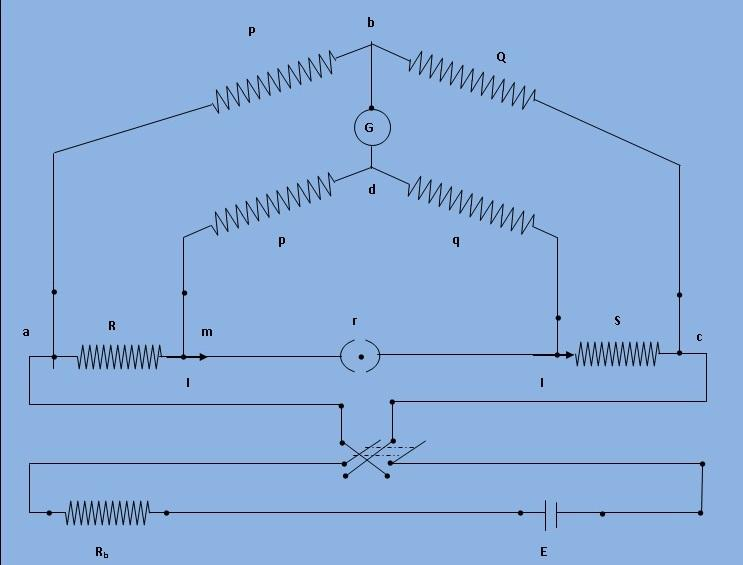
Answer
384.9k+ views
Hint:Low resistance is defined as resistance that is less than or equal to $1\Omega $. Machine armature windings, cables, and ammeter shunts, for example, have a low resistance value.
The Kelvin double bridge is ideally suited for measuring extremely low resistances.
Complete step-by-step solution:
Kelvin's double bridge was used to measure four-terminal low resistances with precision. The resistance of four-terminal resistors is equal to the stated nominal value across two current leading terminals and two potential terminals. This is because the current must enter and exit the resistor in such a way that the current density distribution between the several equipotential surfaces used to determine the resistance is the same or equal. Any contact resistance at the current lead-in terminals is also reduced by the new points.
Additional information:
Circuit Diagram:

The kelvin double bridge has four terminal resistors for the low resistance arms and the second set of ratio arms (thus the name "double bridge"). The Kelvin bridge is depicted in Figure. P and Q represent the first ratio arms. To avoid the effect of connecting lead resistance r between the unknown resistance R and the standard resistance S, the second set of ratio arms p and q are employed to connect the galvanometer to a point d at the proper voltage between points m and n.
Note:
Advantages of Kelvin double bridge:
It can detect resistance values ranging from \[0.1\mu A\] to \[1.0{\text{ }}A\].
There is a reduction in the amount of energy used.
The construction is straightforward.
The level of sensitivity is really high.
The Kelvin double bridge is ideally suited for measuring extremely low resistances.
Complete step-by-step solution:
Kelvin's double bridge was used to measure four-terminal low resistances with precision. The resistance of four-terminal resistors is equal to the stated nominal value across two current leading terminals and two potential terminals. This is because the current must enter and exit the resistor in such a way that the current density distribution between the several equipotential surfaces used to determine the resistance is the same or equal. Any contact resistance at the current lead-in terminals is also reduced by the new points.
Additional information:
Circuit Diagram:

The kelvin double bridge has four terminal resistors for the low resistance arms and the second set of ratio arms (thus the name "double bridge"). The Kelvin bridge is depicted in Figure. P and Q represent the first ratio arms. To avoid the effect of connecting lead resistance r between the unknown resistance R and the standard resistance S, the second set of ratio arms p and q are employed to connect the galvanometer to a point d at the proper voltage between points m and n.
Note:
Advantages of Kelvin double bridge:
It can detect resistance values ranging from \[0.1\mu A\] to \[1.0{\text{ }}A\].
There is a reduction in the amount of energy used.
The construction is straightforward.
The level of sensitivity is really high.
Recently Updated Pages
How is abiogenesis theory disproved experimentally class 12 biology CBSE

What is Biological Magnification

Which of the following reagents cannot distinguish class 12 chemistry CBSE

Which of the following reagents cannot distinguish class 12 chemistry CBSE

Which of the following reagents cannot distinguish class 12 chemistry CBSE

Which of the following reagents cannot distinguish class 12 chemistry CBSE

Trending doubts
Which are the Top 10 Largest Countries of the World?

What is the definite integral of zero a constant b class 12 maths CBSE

Differentiate between homogeneous and heterogeneous class 12 chemistry CBSE

What are the major means of transport Explain each class 12 social science CBSE

Explain sex determination in humans with the help of class 12 biology CBSE

How much time does it take to bleed after eating p class 12 biology CBSE




